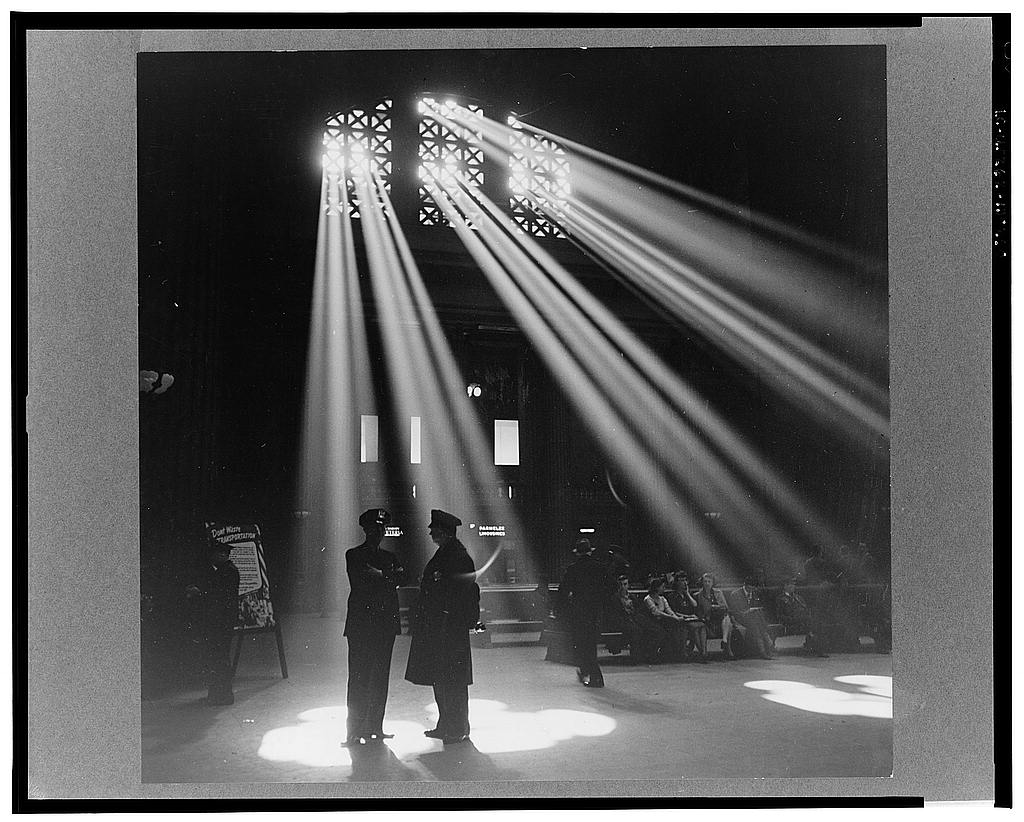
It is about noon, January 1943, in Union Station, Chicago. The massive skylight above the Great Hall has been blackened over as a precaution against air raids, but light streams in through the south windows and the arched grates above the hall. People sit and stand, waiting for trains. Maybe they are there to meet someone or see a loved one off. An official, maybe a conductor, looks off to the left and two Chicago policemen stand silhouetted by a sunbeam.
It is the light we notice first, shining through the grate, catching the dust and smoke in the Great Hall. It is a winter day and the sun is low. It shines through two rows of outside windows that we cannot see and is broken into beams by the facets of the ornate grating. As kids, we called it ‘God Light’ — the shining light from Heaven in the picture cards of Jesus we got on Sundays.
The photographer, Jack Delano (1914-1997), was working for the Office of War Information when he made the photograph. Delano was a musician and visual artist, trained at the Pennsylvania Academy of Fine Arts in Philadelphia. He picked up his first camera on a scholarship trip to study art in Europe and got a job with the WPA photographing coal miners when he returned. In 1940, he was hired by Roy Stryker of the Farm Security Administration as a replacement photographer. There his job was to travel the country taking pictures of life in America. The government provided the cameras and film, paid for the gas and meals, he had to provide the car.
It was, in many ways, the perfect job for a young photographer. Travel the country and take as many pictures as you want. See new places, try new techniques, develop your eye and your style, see if you have something to say. Many of the great photographers of the last century worked for the FSA or its wartime equivalent, the Office of War Information: Dorothea Lange, Gordon Parks, Marion Post Wolcott, Walker Evans, Ben Shahn, and more. Many of them made their best photographs while there.
Delano took many photographs in and around Union Station that January, many of them in the Great Hall with its radiant light and beautiful space. It is fascinating to see how he approached the hall, trying different angles and different framing, trying to capture the light and the space. Most of the photographs are very good but this one, I think, is great.
Light and shadow — the dark shadows of the blacked out hall and the bright white light of the sun — the contrast is dramatic. The sunbeams are like spotlights shining down in beautiful diagonals that give structure to the image. The cluster of sunbeams on the right divide the photograph into two parts, balancing the people in the lower left with the dark space in the upper right. The middle cluster fills the center and lights the waiting people. The sunbeams on the left seem to come right toward us, putting the two police officers into shadow. Our eyes move from the windows, to the sunbeams, to the policemen and back and even though the lighting is dramatic, the overall effect of the image is calm.
There are stories here, unstated: the lone official, the waiting women. One of the two policemen wears a long winter coat. He could be a beat cop stepping inside to warm himself on a cold January day or a supervisor just in to check and see that all is well. The other officer wears lighter clothes; the station is his beat. He looks right at us like he might come over and ask what we are doing.
As great as it is, this is not a technically perfect photo. It is grainy, either not well exposed or poorly developed. There is a light patch on the left side near the official that could be from reflection in the lens. There are also two white arcs, like tiny fingernail trimmings, one near a sunbeam in the center, one on the officer in a coat. These are from kinks in the negative due to poor handling during development. But we don’t notice these flaws when we see the picture. We see the sunbeams, the windows, the officers. We see the people waiting on the benches and in the shadows and space of the hall.
Today the flaws could be edited out in minutes. The blacks could be brought out, the grain obscured, the detail in the shadows made sharper, the dust spots and scratches and kinks removed. It would not be a greater photograph for the work. The heart of the image, its ability to grab our attention, to instill a sense of awe, to make us think and feel about the place and time, the people and the light, would not be improved.
Sometimes a great picture is just a great picture, even with its flaws.
The negative of this photograph and all the photographs of the FSA/OWI are preserved in the Library of Congress. Digital copies are available for viewing and download.
More information on Jack Delano, his life and many accomplishments, is available on his Wikipedia page and at the International Center for Photography website.